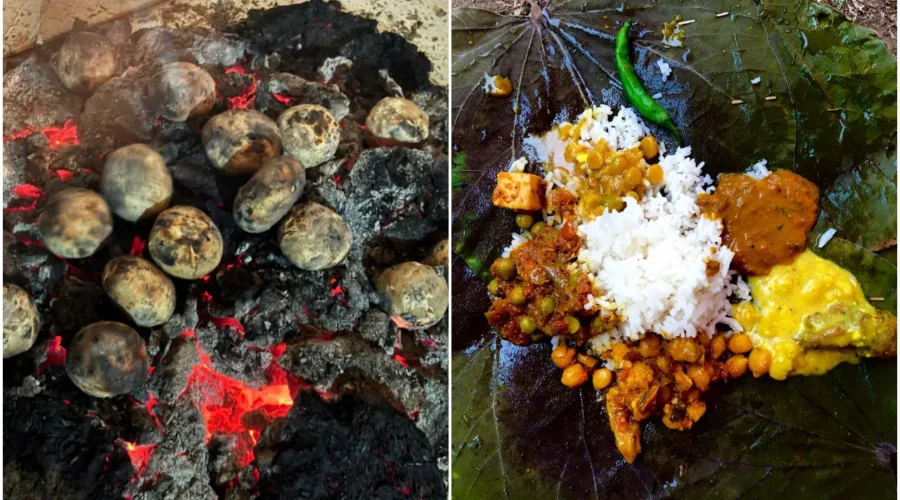World Tourism Day: A traveller`s guide to offbeat culinary destinations in India
If you are someone who travels for culinary immersion, the process of curating a trip can be overwhelming owing to the seemingly endless options. Embarking on a culinary journey is more than just tasting new dishes, it`s about uncovering the stories, traditions, and heart of a place through its food.
This is the philosophy shared by true passionate food enthusiasts who delve into the hidden gastronomic gems of India.
From the soulful “dham” feasts of Himachal Pradesh, celebrated by travel blogger Divyakshi Gupta, to the historic port-city flavours of Kochi, explored by “food hunter” Jade D’Sa, and the honest, simple cuisine of Bihar championed by travel and food blogger Akanksha Prakash, these experts reveal that authentic food experiences are rarely found in tourist traps.
In a country as vast and diverse as India, finding these authentic experiences requires local knowledge, a healthy dose of curiosity, and a willingness to look for what lies beneath the surface. This World Tourism Day, these seasoned travellers will help you discover the true essence of the culinary identity of three distinct regions.
The soulful flavours of Himachal
For Divyakshi Gupta, a travel blogger and experiential trip curator known for her blog ‘QuirkyWanderer’, the magic of Himachal is encapsulated in a single, deeply traditional meal. She recalls her first taste of a `Pahadi` dham, a communal feast prepared for special occasions. “The first time I tasted it, it felt like heaven. A burst of flavours in my mouth. A simple community meal cooked in brass pots and served on leaves, the traditional ‘Pahadi’ dham had not only satiated my tummy but also my soul,” she says.
Himachali Dham: More than a meal
Gupta believes that this particular meal is far more than just food. “Himachali dham is an emotion. Not just a meal. A celebration of flavours, bringing the community together. It is a significant and celebratory event, consisting of a five or seven course meal served with rice and a variety of gravies called Madra. The flavours vary depending on the district it is served in: Kullvi belonging to Kullu, Mandiyali belonging to Mandi, Kangri belonging to Kangra, Bilaspuri belonging to Bilaspur and so on. This rice-based meal is rarely found in hotels because it is made for special occasions such as weddings, temples, festivals, retirement ceremonies, and birth in the family,” she explains.
Driven by her passion, Gupta began curating culinary and cultural trips to the region, with the specific goal of allowing other travellers to experience this authentic taste. “I wanted other travellers to savour this authentic taste; hence I started curating culinary and cultural trips to Himachal, inviting local ‘botis’ or cooks to make Dham specially for my group,” she explains.
The curations are seasonal, timed to coincide with the best of what nature has to offer. The first edition was during the apricot season, and the second during the apple harvest. This approach allows travellers to immerse themselves in the local food cycle, plucking fresh, organic produce straight from the source. “From kiwis to plums to cherries to persimmons to pomegranates to the very seasonal loquat: my groups have plucked them all: Himachal is a fruit paradise (you just need to know the local fruit cycle) and the right contacts who can seek permission for plucking,” Gupta shares with enthusiasm.
Seeking no frill eateries
Gupta addresses a common frustration she hears from tourists. “Tourists come to Himachal and complain that we don’t get local food. It is the same Paneer and Dal Makhani.” She argues that this is because very few actually delve deeper and find spots that cater to authentic Himachali flavours. She highlights Mani Ram dhaba, a simple, no-frills eatery near Naggar in Kullu that serves one of the best Thalis. “The meal includes kadhi, locally sourced organic Rajma, red rice, fern pickle and Siddu. What makes it extra special? The warmth with which the food is served. Dollops of ghee given abundantly,” she recalls.
The gastronome is also a fierce advocate for local dishes that are often misunderstood. The Siddu, a steamed stuffed bun from Kullu, is a prime example. Gupta laments how the dish is misrepresented by tourist-focused vendors. “People have cancelled it on social media, but the truth is they haven’t had the real deal. A true, authentic Siddu is stuffed with a rich filling of walnut, sesame, almond, and poppy seeds, not the inferior potato or cabbage versions sold on the main roads. I have even seen so-called home chefs serving poor copies of this amazing dish,” she clarifies.
Best places to eat in Kullu
Beyond the well-known staples, the Kullu district alone offers a wealth of flavours, from the fermented bread Bhaturoo to the Lingdi (fiddlehead fern) sabzi and the prized Gucchi (morel mushroom). The region`s chutneys are also a specialty, with the extensive use of the rhododendron flower, locally known as buransh, found in everything from wines to tea to chutneys.
Her final piece of advice is a powerful one. She says, “If you are coming to Himachal, come with a local. Get in touch with an expert or someone who is passionate about the cuisine. No one can take you to local spots better than locals themselves! If you come curious, you will go back rewarded. The taste that you will get in the hole in the wall hidden gems, you won’t get it in any 5 star or home chef supper club!”
The culinary crossroads of Kochi
Jade D`Sa, known as ‘That Goan Girl,’ has carved out a significant role for herself as a food and travel blogger. Her work as a ‘food hunter’ for Culinary Culture involves exploring and documenting the authentic flavours and dining experiences. For her, Kochi is a destination that perfectly embodies the spirit of a seasoned traveller. She sees it as more than just a place with good food–it’s a living museum of flavours.
“Kochi has a great mix of coastal and colonial-inspired cuisines, so you`ll find spicy Chettinad curries in obscure eateries to fresh coconut-based mollusk dishes. For a culinary traveller, the city offers a rich tapestry of experiences, from exploring Ernakulam`s bustling markets where spice vendors sell their blends, to discovering old bakeries and trying rare Syrian Christian dishes,” she explains.
According to D’sa, the secret to uncovering the local spots lies in a traveller’s intuition and persistence. “Uncovering these spots demands a traveller`s intuition. Visit the same places for `chaya` every day and strike up conversations with chaiwallahs or fish vendors who`ll point you to family-run thattukadas (street food stalls) serving hyper-fresh seafood curries or biryanis. Time your explorations for peak meal hours and always ask for “nadan” (traditional) versions to cut through any diluted tourist adaptations. It`s this blend of serendipity and local intel that turns a meal into a memory,” she poses.
Uncovering authentic spots: A traveller`s intuition
D’sa’s unwritten rule for finding the best food is simple and direct, “Eat where the locals flock – follow the lunchtime crowds from office buildings or markets, and ignore any place with English menus or Instagram aesthetics. Authenticity thrives in the unpretentious chaos of everyday routines.” She also points out that in the digital age, a quick Instagram story or tweet asking for recommendations can also be a powerful tool, as it can connect you directly with a local or a seasoned traveller who has already done the legwork.
When asked to choose between a street-side stall and a high-end restaurant, the blogger wholeheartedly recommends the thattukadas for an authentic, quick bite. She lists several of her favourites, “When in Kochi, make your way to Vellakkanthaari restaurant for seafood, Balan Kada for beef, and Sree Muruga Cafe for Pazhampori. These places may not offer much in terms of ambiance, but you will enjoy good, tasty food.”
Culinary legacy of a port city
The city’s unique food scene, according to her, is a direct result of its long history as a port city and a melting pot of cultures. “The influences are evident in its cuisine: Portuguese contributions of chili and vinegar-laced curries, Dutch baking methods, Arab infusions of saffron and dates in biryanis, and Jewish pickling traditions. All this, melded with Kerala’s coconut, tamarind, and seafood-heavy palate creates dishes that carry stories of trade routes,” she observes.
To illustrate this fusion, D’sa points to one specific dish, “Meen pollichathu features fish, often pearl spot, marinated in a fiery masala of chili and turmeric, then wrapped in a banana leaf and baked—a technique that echoes the oven methods of the Portuguese and Dutch. The dish’s tangy, smoky depth, often served with ghee rice, captures Kochi’s port-city soul.”
Ultimately, the expert concludes with one piece of advice for anyone curating their own culinary journey, “Curiosity and conversation are your best tools for finding authentic flavours. Ignore the tourist traps and explore with an open palate.”
The unsung plate: Why Bihar`s culinary scene deserves a second look
While the northern state of Bihar just doesn`t come up in group chats discussing culinary expeditions, avid traveller and food enthusiast, Akanksha Prakash, tells us why it should be on your radar. For this Ranchi dweller with roots in Bihar, documentation of culinary and travel adventures with her husband Yash Dadlani through @Kokichokha is a labour of love.
A culinary philosophy of simplicity
Their commitment to food is so strong that “chokha” even formed one half of the wedding hashtag. “While Litti Chokha is iconic, Bihari cuisine goes far beyond it,” Prakash notes. Beyond this famous dish, she adds, you`ll find savoury dishes like Dahi Chura Gud, Ghooghni, and Dal Pitha, as well as sweets like Anarsa, Tilkut, and Parwal Mithai, which are all deeply rooted in local traditions.
When asked to describe the region`s culinary philosophy, Prakash says that the food is defined by its simplicity, “If I had to sum up Bihar’s culinary philosophy. I’d say it’s deeply rooted in simplicity, seasonality, sustainability, and self-sufficiency. Geographically, Bihar lies on the Indo-Gangetic plain which makes it suitable for intensive agriculture. Staples like sattu and makhana aren’t just nutritious; they’ve been used for generations because they’re locally cultivated. It’s a kitchen culture that’s naturally sustainable—supporting local farmers, minimising waste, and celebrating seasonal produce without even trying to be `trendy` about it.”
What’s the most memorable food she has had? “I would say, Chhath Puja is the biggest festival for us. The Nahaaye Khay prasad is a simple, pure, and sattvic meal made on a mud stove consisting of Kaddu Bhaat, Chana Dal, and other vegetables. This sacred meal is prepared without onions or garlic, with a focus on the purity of ingredients.”
Exploring regional delicacies
Bihar can be divided into distinct regions based on language, culture, and food: the Mithila, Angika, Tirhuth, Bhojpur, and Magadh regions, each with their own unique cuisine. The blogger recommends exploring the Mithila region to experience the best of regional delicacies. “The saying `Pag-pag pokhar, maach, makhaan` (ponds at every step, fish, and makhana) is central to Mithila`s identity. “Ninety percent of the world`s makhana is cultivated here, and it’s primarily used for pujas. It is also a key ingredient in dishes like Makhana Kheer,” she explains. The region`s food, she adds, is deeply influenced by water resources, which also makes fish, often cooked in mustard oil, a popular local delicacy.
The best food is rarely found where it is most advertised, but how do travellers seek authentic flavours in a place where eating out is not a part of their culture? Her advice is simple, “Seek places busy with locals. For litti chokha, prefer places that roast litti on charcoal or wood; the smoky crust is essential. And most of all, expect strong mustard oil flavours.” Prakash’s insights show that Bihar`s cuisine is much more than a collection of dishes; it`s a reflection of its culture, history, and a deep-rooted respect for nature. It’s an honest, unpretentious food culture that offers a truly authentic experience. By moving beyond the generic guidebooks and following the lead of locals, a trip to Bihar can become an unforgettable culinary expedition.



